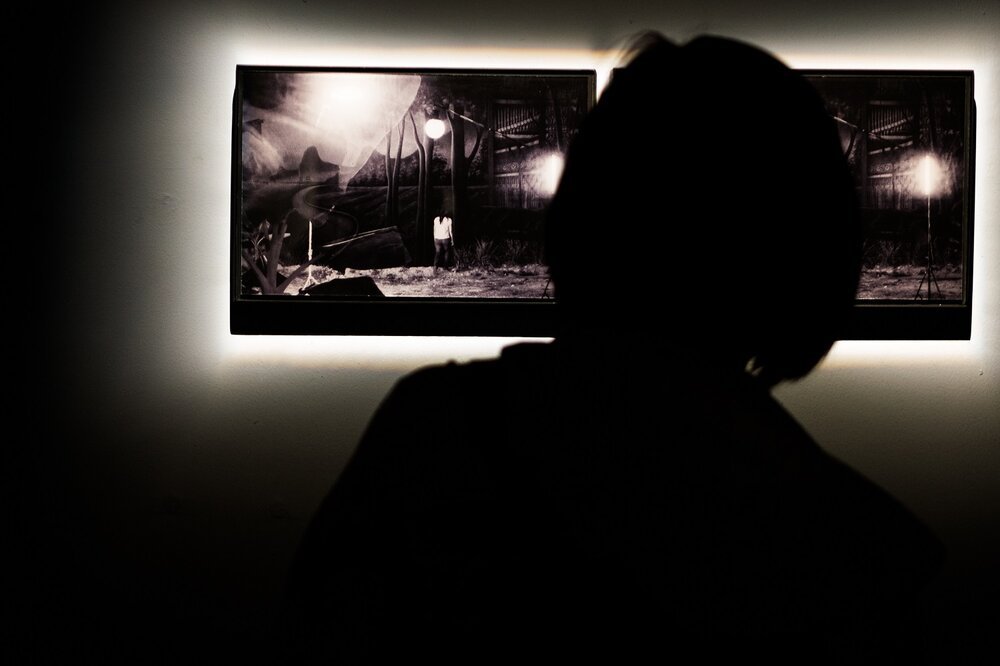Review of Apichatpong Weerasetakul’s ‘Almost Fiction’
New photographic work at Gallery Seescape
By David Willis
Apichatpong Weerasetakul, 'Soldier Series - A Young Man at Twilight', 2019, giclée print. Image courtesy of Gallery Seescape.
Renowned for being the first Thai director to win the Palm D’Or award at the Cannes Film Festival for his 2010 feature film ‘Uncle Boonmee Who Can Remember His Past Lives’, Apichatpong Weerasetakul has also received wide recognition in visual art circles. In 2012, his work was featured in Documenta 13. And in 2016, a large-scale retrospective of his works was launched at the MAIIAM Museum of Contemporary Art in Chiang Mai before traveling to museums in the Philippines, the United States, and Taiwan. Given his illustrious track record of international screenings and exhibitions, it is a unique pleasure to see his latest photographic work presented at Gallery Seescape in Chiang Mai, the city which serves as his home base.
The show spans across two separate rooms, connected by a doorway that was specially carved out for this exhibition. The large sliding door to the main exhibition space remains bolted shut, forcing visitors to begin by entering the smaller back room, where they encounter a series of modestly sized black-and-white photographs depicting nocturnal scenes, meticulously lit with spotlights to dramatic effect. All save one of these works are presented as diptychs, which encourages the viewer to create narrative connections between the abutting prints, as one would when stitching together the frames of a film.
Apichatpong Weerasetakul, ‘Insomnia Series - Bullet’, 2019, acrylic print diptych, exhibition installation view. Image courtesy of Gallery Seescape.
The first diptych on the right wall, titled ‘Insomnia Series - Bullet’, depicts a woman spitting a rifle bullet out of her mouth. Aficionados of Weerasetakul’s films will immediately identify her to be Jenjira Pongpas, the actress with the lame foot who starred in ‘Uncle Boonmee’ (2010) and ‘Cemetery of Splendor’ (2015). Further, a true film buff would recognise this as a reference to ‘Meshes of the Afternoon’ (1943), the surrealist short film by Maya Deren and her husband Alexander Hammid, in which Deren spits a key out of her mouth.
The Maya Deren connection is crucial to the show. Deren was an anthropologist and filmmaker famous for her work on Haitian spirit possession, and Weerasetakul also has an anthropological bent to his work, as many of his films have addressed the supernatural phenomena of Thai cosmology, and ghosts in particular. Without depending too much on special effects, he frequently uses un-spectacular cinematic devices to evoke the phantasmagorical. For instance, in ‘Cemetery of Splendor’, a pair of young women introduce themselves to the character played by Pongpas, casually informing her that they are ghosts before thanking her for leaving an offering at their shrine.
Apichatpong Weerasetakul, ‘Insomnia Series - Ghost Girl’, 2019, acrylic print diptych, exhibition installation view. Image courtesy of Gallery Seescape.
Analogously, in ‘Meshes of the Afternoon’, Deren and Hammid employed simple film techniques to tell the story of a woman going insane; for instance, at one moment we see Deren staring out of an upstairs window, watching an ominous grim-reaper type character walk down the driveway, and the next moment we see her running down that same driveway, chasing after the ghost. Now consider the diptych ‘Insomnia Series - Ghost Girl’: on one side we see a girl with her back to the camera, while on the other side the (ghost) girl is gone. The background to this scene is a painted backdrop depicting trees, rice-paddies, and mountains in the distance, while in the foreground we see actual dirt, plants, and lighting rigs, which self-consciously undermine any illusory effect and heighten the tension between fact and fantasy.
Apichatpong Weerasetakul, ‘Soldier Series - A Young Man at Twilight ’ (left) and ‘Soldier Series - Embrace’ (right), 2019, giclée prints, exhibition installation view. Image courtesy of Gallery Seescape.
Three concrete steps enticingly lit by a spotlight lead us up into the primary exhibition space, where a series of lightboxes depict what appear to be soldiers posing in the jungle at night. Wearing camouflage fatigues, their faces are mysteriously obscured by white light, which once again evokes ‘Meshes’, in which the grim reaper character has a blank mirror for a face. These works raise a lot of questions: are these actual soldiers, or actors? Are they in the jungles of Thailand, or perhaps in Colombia, where Weerasetakul has been shooting his latest feature film? And last but not least, are they coming to steal our life like the grim reaper, or are they the ones whose lives have been stolen?
Rich in its ambiguity, the show serves as a valuable appendix to the artist’s work as a whole, although it may prove bemusing to the uninitiated. In his catalogue essay for the exhibition, the curator Sebastien Tayac quotes Umberto Eco (1932-2016), who wrote that “the work of art is a fundamentally ambiguous message, a plurality of signifieds that coexist within a single signifier… Today, this ambiguity is becoming an explicit goal of the work, a value to be realised in preference to all others.” Such ambiguity is especially crucial in the context of Thailand, which has been ruled by a corrupt military government ever since the coup of 2014, forcing artists to launch critiques of the regime from a place of deniable plausibility. And that is precisely what Weerasetakul does in this show: subtly revealing the reality in fiction, and the fictional within the real.
‘Almost Fiction’ is on show at Gallery Seescape from 21 December 2019 to 21 Feburary 2020. For more information, visit galleryseescape.co.














